Approaching the Starting Line
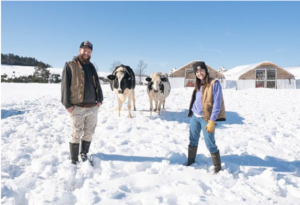
There’s always been something romantic about a farm in New England, through colorful images of red barns, silos, and grazing cows against a quintessential autumnal landscape. Yet, over the past 50 years, the region has lost more than 10,000 dairy farms. Less than 2,000 remain; and Mayday Farm is one of the fortunate few.
Located in Leeds, Maine, Mayday Farm owners Katie Gualtieri and Haden Gooch are part of a young farmers’ movement to regenerate what was once conventional farmland with the goal of building a sustainable, community-based business. They are not from farming families, but they share a love for agriculture. Katie left a 10-year career in international development, working on issues ranging from land rights to food security in Africa. Instead of making funding decisions from an office desk in Washington, DC, she decided to become directly involved in farming as a living in order to preserve the land and build back small farming communities here at home.
After working together on a direct-market livestock farm in Virginia, they moved to Maine, where Haden worked for two years in a Dairy Grazing Apprenticeship (DGA) with the Wolfe’s Neck Center for Agriculture and the Environment in Freeport, a non-profit organic dairy program that provides immersive training in regenerative practices and farm management. Meanwhile, Katie worked on small organic dairies with value-added operations. After years of hands-on learning, Katie and Haden were ready to start their own farming operation.
Land Access and Farm Transfer
Accessibility of land and financial resources present challenges for young farmers. “Finding a farm and land that was suitable for dairy was really challenging,” says Katie. “So much land is commercialized at this point that farmland is dwindling and what does exist is really, really expensive.” Especially in Virginia, which is why they set their sights on Maine where land is more affordable. Fortunately, by completing the DGA program, Haden automatically met the qualifications for a USDA Farm Service Agency (FSA) loan.
Formerly Sander-Lou Farm, Mayday had previously been a 350-acre conventional dairy farm in the same family since the 1940s. By the turn of the century, the owners were looking to retire, and they began leasing about 100 acres of open land on the old farm to neighboring farmers. Then, in 2020, the non-profit Maine Farmland Trust purchased the property. Haden and Katie were able to lease a portion of the farm for a year while they were going through the FSA loan process. They closed on their dream purchase in 2021. By the end of the year, Maine Farmland Trust had protected at least 20 farms, preserving more than 2,000 acres as “forever farmland.” Mayday Farm was a part of that.
Audio PlayerDairy Farm Transfers: click to listen to this 3 minute audio clip where Katie speaks to OFRF about experiences with farm transfer as young dairy farmers.
Pasture and Soil Restoration
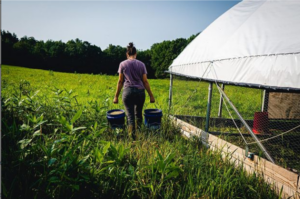 One of the priorities for Haden and Katie was to restore nutrients to the land to enhance the soil on their farm. “The land had sat fallow for a period of time and also had been rented off and on for about a decade. A hay crop was taken off, for example, and no nutrients were put back. A couple of parcels had been farmed in corn continuously for five or six years, and we were having trouble with those areas. We wanted to get it back into perennial grass and grazing annual production in other areas,” says Katie.
One of the priorities for Haden and Katie was to restore nutrients to the land to enhance the soil on their farm. “The land had sat fallow for a period of time and also had been rented off and on for about a decade. A hay crop was taken off, for example, and no nutrients were put back. A couple of parcels had been farmed in corn continuously for five or six years, and we were having trouble with those areas. We wanted to get it back into perennial grass and grazing annual production in other areas,” says Katie.
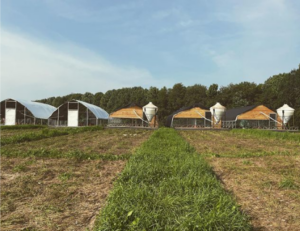 Haden had already launched a pasture-raised poultry operation in 2020 on leased land. Through a contract with a New England based meat company, the chickens consume only non-GMO feed and are antibiotic free. Mayday Farm now does about 24,000 broiler chickens from April through November. “They are great little fertilizer tools,” Katie says. “We rotate them once a day to a different pasture on the farm that we thought really needed help. Now we get the benefit of all of the poultry manure going right onto the fields, and we’re really excited to see the impact of that.”
Haden had already launched a pasture-raised poultry operation in 2020 on leased land. Through a contract with a New England based meat company, the chickens consume only non-GMO feed and are antibiotic free. Mayday Farm now does about 24,000 broiler chickens from April through November. “They are great little fertilizer tools,” Katie says. “We rotate them once a day to a different pasture on the farm that we thought really needed help. Now we get the benefit of all of the poultry manure going right onto the fields, and we’re really excited to see the impact of that.”
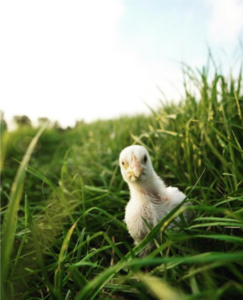 Even though this portion of Mayday’s farm operation is not certified organic, this management-intensive approach to grazing helps to restore microbiota in the soil and reflects Mayday’s commitment to environmental stewardship best practices.
Even though this portion of Mayday’s farm operation is not certified organic, this management-intensive approach to grazing helps to restore microbiota in the soil and reflects Mayday’s commitment to environmental stewardship best practices.
Organic Certification
The poultry operation adds diversity to Mayday’s revenue stream, and alongside the certified organic dairy operation, helped secure the FSA loan. After the farm purchase was finalized, Haden immediately had the land certified in mid-2021 and applied for a provisional application to certify the cows through the Maine Organic Farmers and Gardeners Association (MOFGA), which is Maine’s USDA Accredited Organic Certifier. The cows arrived in January 2022, and they began shipping organic milk that month.
Fortunately, there were very few bumps in the road to certification because Haden had made contacts during the DGA program that connected him to Stonyfield Organic. Katie also credits MOFGA for being a helpful and supportive certifier, which enabled Haden and Katie to recertify dairy cows they were purchasing from a New Hampshire organic dairy farmer who needed to liquidate because he had reenlisted for active duty in the military. The cows were already producers for Stonyfield. Still, to ease the purchasing and transition process, Katie advises others to get to know the land and its history concretely in the transition from conventional to organic farmland.
Monitoring Pasture Management with Apps
A little more than a year later, Mayday enjoys a thriving wholesale certified organic dairy enterprise through the direct supply program with Stonyfield Organic. And now that Haden and Katie are doing rotational grazing with poultry and close to 40 cows, they’re using tech to help them stay on top of things.
“We do all of our grazing management in an app called Pasture Maps. We can track all of our moves in real time and how long we were on a specific piece of pasture,” says Katie. “And that’s really great for recordkeeping. We rotate the cows every 12 hours and really want to pay attention to how we graze the land, how much residue we leave, and how much rest we give to each pasture.”
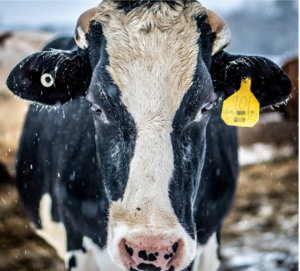 Mayday’s intention is to build back the soil and forage species and to find balance in their conservation practices. “We did a whole batch of soil samples just to get a baseline for where we’re at with organic matter and to get an idea of where there might be mineral deficiencies on the farm,” says Katie. “We spread our stored manure from the cows on our hay fields, but we’ve also been using organic wood ash as a minimal supplement where we need to change the soil pH.” They are also in the early phases of working with the USDA National Resources Conservation Service (NRCS) Environmental Quality Incentives Program (EQIP) and submitted an application in 2022 for infrastructure to help mitigate manure run-off and provide better outdoor access for the dairy herd during the winter months.
Mayday’s intention is to build back the soil and forage species and to find balance in their conservation practices. “We did a whole batch of soil samples just to get a baseline for where we’re at with organic matter and to get an idea of where there might be mineral deficiencies on the farm,” says Katie. “We spread our stored manure from the cows on our hay fields, but we’ve also been using organic wood ash as a minimal supplement where we need to change the soil pH.” They are also in the early phases of working with the USDA National Resources Conservation Service (NRCS) Environmental Quality Incentives Program (EQIP) and submitted an application in 2022 for infrastructure to help mitigate manure run-off and provide better outdoor access for the dairy herd during the winter months.
Diversifying Markets and Local Community Food Security
In the future, they would love to add some balance to how they sell their products. Right now, they’re appreciative of the steady wholesale market that the poultry and organic milk contracts provide. But Haden and Katie hope to try a little bit of direct marketing of some of their chicken and maybe some raw milk so that they can interface more with their local community.
“We’d like to maybe set up a little farm store here or tag along with some friends who are already in farmers markets so that we can sell some chicken there,” says Katie. “It bothers us that everything we grow is leaving the farm for the most part.”
Part of the reason Haden and Katie both love farming is for the community impact and effect they can have on the local economy. “We have a milk truck driver that’s keeping their job; and we have our grain supplier, and we have a local mechanic, and we have a Maine-based company that does all of our servicing for our milking equipment. This is why it’s so important to keep farms in business,” Katie says. “Aside from the direct impact we can have with our own products, we are also supporting other activity within the community that strengthens our local economy.”
“When you have a highly industrialized food system, you can see what happens when something comes along like COVID, which took out a major meat slaughtering facility and then the system starts to fall apart. This needs to be addressed, and we need to start moving toward growing a more equitable and safe food system with a multi-faceted approach.”
“Leeds is a strong farming community,” says Katie, “but there are pockets of food insecurity. You have to drive out of Leeds in order to get anything. There is no downtown area, no grocery store, no gas station.”
A new generation of farmers wants to make organic food access much more community-centric. Mayday has long-term goals, for example, of providing community-based meals for locals. “We need to change accessibility so that food is a more democratic thing than it is right now,” says Katie. “I think it’s important what the future generation of farmers looks like and how we make food more resilient within communities.”
Moving Forward into the Future
If this is what the young farming movement is all about, then the future of food and farming in this country is in good hands. In Maine, and elsewhere in the country, there are farmers who are aging out of the system and young people who are stepping in to take over those roles. The transition isn’t always easy when it comes to giving up something a farming family has done for generations. Like Haden and Katie, many people in this fresh generation of farmers did not grow up on farms. Yet they see themselves as stewards of the land and of the animals.
Through their intentional approach to grazing, Mayday hopes it can become part of the solution rather than the problem when it comes to issues like food security and climate change. “We are conscious of how we as small farmers have the opportunity to make choices in terms of soil building and carbon sequestration, and we want to be aware of our overall impact when it comes to climate change,” says Katie. “We want to approach farming in the most responsible way possible within the organic framework. But even if there wasn’t an organic label, this is the way we would choose to farm anyway.”
. . .
Links for further reading:
Wolfe’s Neck Center for Agriculture and the Environment
Maine Organic Farmers and Gardeners Association


